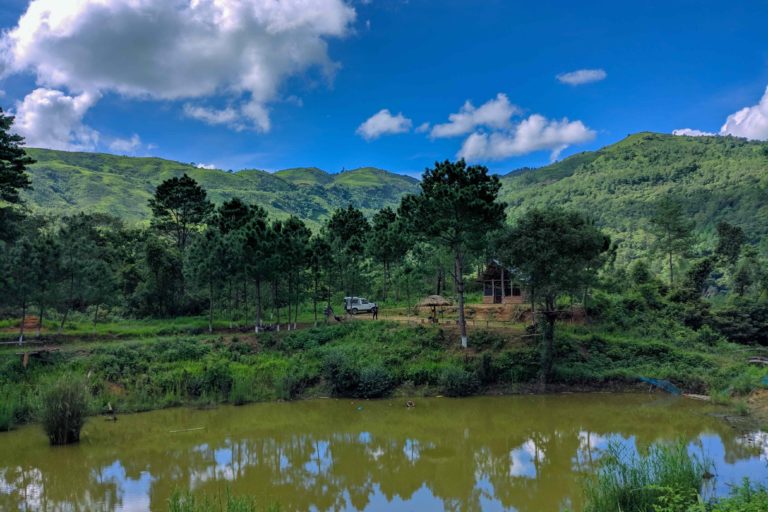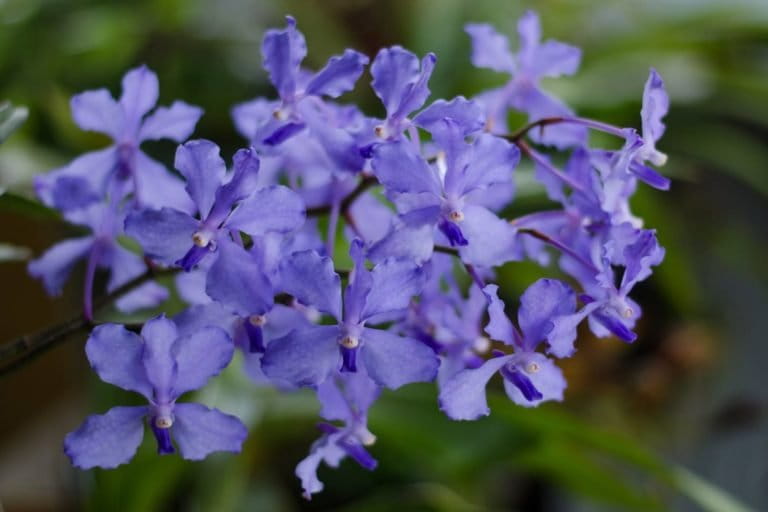- Orchid species diversity and richness indicates that only protected areas and nurseries are inadequate to develop sustainable orchid conservation and regeneration programme.
- Over 60 rare orchid species have been documented outside protected areas by members of the local community in Phalee a small village in Manipur’s Ukhrul district.
- Ng Ngshangva, a founding member of the Phalee Biodiversity Management Committee and microsite Rainforest Biodiversity of Phalee writes about the community’s involvement in conserving its orchid heritage in this commentary.
It is an interesting fact that all 29,000-odd species of known orchids have been listed in Appendix I or Appendix II of the Convention on International Trade in Endangered Species (CITES); they are the single largest group of flora or fauna for which international trade is regulated.
Despite having some of the best legal protections, wild orchids remain under immense threat for the illegal trade globally. The Orchidaceae is one of the largest and highly evolved families of angiosperms on earth, consisting of 29,000 species with more than 850 genera. Many are still being discovered, while several may still be unknown to the world, and many are going extinct mainly from illegal trade, logging, habitat loss and forest fire.
They are one of the natural indicators of ecosystem health, and their presence signifies that the ecosystem is vibrant and lively. The ecological role of orchids in the ecosystem is often undermined or there is unknowingly a bias against them as they are considered just a parasitic plant species. They are slow-growing, and in an ecosystem, their vanishing indicates that the process has reached the irreversibility stage. The dependence of orchids on mycorrhiza for germination and pollinators (mainly insects) for their propagation are classic cases of interaction with other biotas in nature. That is why it is imperative to conserve and propagate them.
The Botanical Survey of India has reported that 1,256 species or taxa of orchids belong to 155 genera and 388 species are endemic to India. Northeast India, a biodiversity hotspot, sustains a high number of orchid species of about 856, and the Western Ghats have high endemism of orchids. Amongst them, 34 species of orchids are identified as the threatened plants of India and many are endemic to different states and micro-climate region of the northeast. About 300 species belonging to 69 genera of the family Orchidaceae have been reported from Manipur. It is conspicuous from literature and data that they are distributed widely in India and frequently beyond Protected Areas (PAs).
The orchid species diversity and richness indicated that only PAs and nurseries are inadequate to develop sustainable orchids conservation and regeneration. At the same time, orchid conservation cannot happen in isolation, it involves all associated flora and fauna. It is time that a concerted and focused approach towards conservation of orchids beyond the PAs needs to be taken up. Conservation and preservation, in general, have become much more meaningful in the prevailing situation drawing attention to zoonotic diseases, natural calamities, habitat destruction and their links with biodiversity loss, anthropogenic, the vulnerability of global supply chains and issues of sustainability.
The economic value of the orchids as cut flowers and potted plants run into multibillion-dollar in international trade, and the import continues to rise in northeast India from southeast Asian countries. So, how does this deficit gap arise despite harbouring a wealth of 1,256 orchid species?

Most of the orchid-rich areas in the northeast region of India are outside PAs and remain unexplored. The Biodiversity Management Committee’s documentation and surveys in Ukhrul are in this unspecified category. There is a need for in situ conservation measures with beneficial provision to rescue, regenerate, conserve and scale-up orchids propagation as expressed by many orchid lovers, experts and researchers before it is too late. The main threats to orchids in this region are habitat destruction and fragmentation from traditional fuelwood extraction, logging and the slash-and-burn land-use system for jhum or shifting cultivation.
In the process, the orchids and the associated flora and fauna are destroyed. The Biodiversity Management Committee analysed the extent of the forest cover damage using Global Forest Watch web tool which revealed that in 2000, 82 percent of Ukhrul was tree covered with 362 kha (kilohectare) under natural forest, 3.29 kha plantations, and non-forest of 73.9 kha. From 2001 to 2019, it lost 35.0 kha of tree cover, equivalent to a 9.6 percent decrease in tree cover since 2000; 14.8Mt of carbon dioxide was emitted or lost through loss in tree cover in that time. Between February 1, 2020, and January 30, 2021, it experienced a total of 2,161 VIIRS fire (webtool for fire monitoring) alerts. In these rural areas, the traditional system of livelihood or the economic dimension comes to the forefront because it involves devastating exploitation of natural resources. There is an overall lack of awareness of environmental deterioration or conservation in this region.
Most of the government-supported environmental programmes are in contradiction of their way of livelihood activities and traditional land-use system. And they see the programme as against or a form of exploitation. Moreover, they live hand-to-mouth and they need the land for food production, and they can’t wait for years to earn income from the project.
One simple way to bring change is to let them know that the programme is for their own, and allay the misconception that it will be taken over by the government. Secondly, another way to undertake this is to educate and involve local communities in regeneration and conservation of these flowers and provide institutionalised funding, awareness or rehabilitation mechanism. Also, the local communities can create conservation areas and manage trails, tourism activities and mass multiplication to create the economy from bioresources. Their role is crucial to conserve the flora and fauna beyond PAs and link them with the institution. In this regard, traditional community reserve forests of this region have achieved conservation objectives, and demonstrate the success story of community livelihood sources. This successful practice of conservation can be emulated and further improved through scientific intervention and investment in natural resources conservation.
From Phalee, a small village of about (2.18 kha approx.) in Manipur, India which is outside the PAs, at least over 60 rare species have been documented. Mostly rare and other unidentified species belonging to different genera of Orchidaceae are documented and preserved at Betterson’s Mini-orchidarium. They are curated in a microsite Rainforest Biodiversity of Phalee founded by Phalee Biodiversity Management Committee with India Biodiversity Portal which is a unique repository of knowledge and a reference tool for authenticating botanical components and catalogued with botanical and local names. It is a web-enabled system that facilitates citizens to access the electronic People Biodiversity Register (e-PBRs). Ironically, it was observed that highly threatened species of orchids specified in schedule VI (plants) of the Wildlife (Protection) Act, 1972, such as Lady’s Slipper, Blue Vanda and Red Vanda have been documented frequently here. Rather species like Coelogyne barbata, Neogyna gardneriana, etc. are very rare. The limited number of plants observed and distribution suggest that they may be threatened. However, until further information, they should be listed as Data Deficient according to IUCN criteria. These challenges were pointed out by Vishwas Chavan and Vinod Mathur, 2020 in their review on electronic PBRs about documentation, validation and accessibility.
Among them Neogyna gardneriana, Dendrobium denudans D.Don, Eria coronaria (Lindl.) Rchb.f., Malaxis unifolia Michx. 1803, Phalaenopsis sp., Brachycorythis obcordata (Lindl. ex Wall.) Summerh. are rare, and they are identified by orchid experts of Kew Garden, London. There is a clear threat to their continued existence. It means the habitat is disappearing from deforestation, logging, forest fire, distinctive traditional land-use system, lack of rehabilitation and undoubtedly climate change. These rich orchids that have endured for millennia are fragile and are increasingly vanishing from the wild so are the words and knowledge associated with them. One of the sad things is that many of these disappearing forests have barely been explored by experts.

An orchid lover and government school teacher, Ng Betterson of Phalee village has said that the orchids are disappearing at a fast pace in this village. He said orchids are used as a calendar, specifically as a seasonal indicator (Thunia alba (Lindl.) Rchb.f.). They are associated with symbolism and metaphors infused with traditional and cultural thoughts. He further elaborated that orchids are intimately linked with the culture and heritage of the village. The local names of flora and fauna are not presentable or used for scientific identification. It makes it very difficult to correlate with scientific literature.
A large majority of orchids are found on trees, moss, rocky areas and grasslands. They are frequently transplanted/relocated near the home, and they are used for matrimonial activities (Arundina graminifolia (D.Don) Hochr.), and some are for prestige (Cymbidium iridioides D.Don) and some are cultural symbols (Dendrobium chrysotoxum Lindl.). Betterson introduced Indian stingless bee (Tetragonula iridipennis), a native species for pollination in his mini-orchidarium to propagate and conserve not just the wild type and gene pools but also the ethnobotany and culture attached to them. Now, this village boasts the greatest number of orchids collection in Ukhrul where every household rears or keeps two or more orchids; they even mark in the wild where they grow in their natural habitats. Stepping into the village, you will find all the orchids at your own pace in a fascinating paradise evoking the sights, smells and sounds of nature.
To go a step further we must identify endangered and endemic species, and plan to multiply through technological interventions and re-introduce them in their native regions supplementing the in situ conservation. An institution-based survey and status of the species from different regions in the country are needed to ensure continuity and proper monitoring and helps in taking timely actions.
Besides, those species which have commercial value have to be propagated and made available for commercial purposes. This will reduce the pressure on wild plant collection and ensure a successful conservation programme. In the long run, it will not only meet the increasing demand in the country but have export potential. Since India has a vast number of orchids, hilly areas have orchids flowering almost throughout the year. By creating orchid conservation areas, tourists, college students and local people can be made aware of this plant wealth and its significance.
The community will manage and implement all the programs and organise orchid trails and tours to create awareness about conservation and earn revenue for the community. Orchid seed banks and germplasm banks should be established in different areas in the country by investing in nature to create the economy from bioresources through departments, university, NGO, PAs, companies and institutes with real intent and conviction.

The author is a founding member of the Phalee Biodiversity Management Committee and microsite Rainforest Biodiversity of Phalee.
Banner image: The Phalee Biodiversity Management Committee (BMC) in Manipur has documented orchids and has created a mini-orchidarium. Photo by Phalee BMC.
